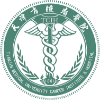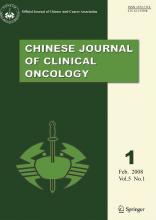Abstract
OBJECTIVE To analyze the clinical manifestations, neuroimaging and pathological characteristics of primary central nervous system lymphoma (PCNSL) with a normal immunity, and to explore the methods of treatment and diagnosis.
METHODS The clinical, laboratory, imaging data and pathological findings and therapeutic efficacy of 31 cases with pathologically proved PCNSL, during a period from July 1995 to June 2006, were analyzed retrospectively. The method of surgery, used in combination with chemotherapy and radiotherapy, was evaluated in 18 cases versus a simple surgical procedure used in 5. Among the total cases, a CHOP regimen was employed in 11 and Teniposide (VM26) plus Semustine (me-CCUN) was used in 7 cases.
RESULTS PCNSL had a variety of clinical features, so that its misdiagnosis rate was high. The main clinical findings of PCNSL included intracranial hypertension and (focal) neurologic impairment. No positive result was found in the CSF cellular examination. All of the 31 cases were B-cell lymphoma. Twenty-four of the 31 cases were followed-up, with a follow-up period from 6 to 98 months. The median period of survival of the group who underwent surgery in combination with chemotherapy and radiotherapy was 20 months, while the group with simple surgical therapy was 10 months.
CONCLUSION Specific clinical manifestations were usually absent in the patients with PCNSL, giving an uncertain preoperative diagnosis and a poor prognosis. Pathological examination is the only reliable method for a final diagnosis of the disease. The main objective of surgical therapy is to relieve the intracranial hypertension caused by the tumor. Recurrence may occur in a short period following the simple operation. Therefore combined therapy, i.e. surgery plus additional radiotherapy and chemotherapy, should be adopted. This is the key point for extending survival time and improving the quality of life.
keywords
Introduction
Primary central nervous system lymphoma (PCNSL) is rare among CNS malignant tumors, including primary malignant intracranial, or intraspinal lymphoma. It is an unusual type of non-Hodgkin’s lymphoma[1], accounting for 0.5%~1.0% of intracranial tumors (ICT)[2]. However there has been an increasing incidence of this tumor in recent years. In addition, early diagnosis of the disease is difficult and the prognosis is poor. To further understand PCNSL and improve the diagnosis and treatment of the tumor, an analysis of the 31 PCNSL patients treated in our hospital, during the period from July 1995 to June 2006, was conducted.
Materials and Methods
Clinical data
Of the 31 patients in this group, 18 were males and 13 were females. The age range was 25 to 71, with an average of 49.8 years. No HIV antibody was found. Neither malignant tumor, nor organ transplantation history was recorded. The period between the appearance of symptoms and the first visit varied from 3 days to 19 months (Table 1).
Major clinical data of 31 PCNSL cases.
Clinical manifestations and physical sign
Clinical manifestations were diverse in our group, without specificity (Table 1).
Auxiliary examination
Imageological examination and tumor site
In this group, a CT examination was conducted in all 31 patients, among which 18 received a reinforced CT scanning. MRI examination was conducted in19 cases, with all the cases undergoing enhanced scanning. Aside from 2 cases with apoplexy, tumor focus with a low isodense image was found in the CT scanning of other cases. In MRI scanning, there was a low isodense image signal of T1WI, and a high isodense image signal of T2WI. Round, rounded-like, or irregular tumor foci were seen in the CT and MRI examinations. The tumor focus image was more distinct after enhancement scanning, with a clean margin. The circumsciption looked like a non-homogenous loop and lump, or well-distributed tiny foci, with a conspicuous surrounding digitiform edematous zone. In our study, solitary invasion occurred in 29 cases and multiple invasion in 2. Both groups had 2 foci, i.e. the former one with the foci at the left frontal lobe (FL) and right cerebellum, and the other at the homolateral FL and occipital lobe. There were a total of 31 tumor foci, among which 31 were located at the tentorium of the cerebellum and 2 at the cerebellar hemisphere. See Table 1 for detailed distribution. The maximum tumor volume was 7.5×6.5×5.0 cm, and the minimum was 2.0×2.0×1.5 cm. A conclusion can be made that no specific appearance was evident from CT or MRI scanning, and it was difficult to distinguish PCNSL from the tumors such as neurospongioma and metastatic tumor, etc. Compared with CT, MRI was of less value in diagnosis.
Ambient hemogram
In the 31 cases the peripheral WBC differential showed that the lymphocytes were less than 30% of the total WBC in 18 of the total cases, they were 30%~40% in the 12 cases and 40%~50% in 1 case. Statistical analysis showed that the lymphocyte increase was not significant.
Examination of the cerebrospinal fluid
Only 9 patients’ cerebrospinal fluid was examined, and 7 of these had fluid with a clear and transparent appearance. There were 2 cases in which a slight turbidity was found. The white blood count was 1~12× 106/L. There was an increase of the protein quantity in 3 cases, with a quantitation of 450~1,050 mg/L, and the protein content was normal in 6 cases, without finding tumor cells present.
Pathological examination
All the cases in this group were B-cell lymphomas. Microscopic examination showed the tumor tissue was diffuse and conglomerate in PCNSL, with a lamellar distribution. The volume of the tumor cells was mostly the same, with less cytoplasm and large nuclei. A sleeve-like infiltration of the tumor cells in the blood vessels occurred, and mesenchymal composition was relatively less. An overt bleeding, or lamellar cellular necrosis was not found in most of the cases (24), and fragmented cellular necrosis could be seen in 2 cases, without calcification. Results of immunohistochemical assay for cases of the group with lymphoma were as follows: LCA positive, CD20 positive and GFAP negative.
Results
Treatment
In the 31 cases of this group, radiotherapy and chemotherapy were carried out in 18 cases. In 2 of the cases intra-operative implantation of a radioactive particle 125I was performed, in 6 cases surgery combined with radiotherapy was conducted, and in 5 cases only surgery was ustilized. X-knife with chemotherapy, following a stereotaxis biopsy, was conducted in 2 cases. Among the 18 cases, 11 cases received the CHOP regimen, those of the other 7 cases received Teniposide plus the MeCCNU regimen. There was no significant difference in the survival time between the two groups, and there was only a slight side reaction in the latter group.
Follow-up
Of the 31 cases, 24 were followed-up for a period of 6~98 months. Seven of the cases succumbed and 11 patients are still living. The median survival time of the group with excision combined with radiotherapy and chemotherapy was 20 months, and the 3-year survival rate reached 44%. The median survival of the patients in the group receiving simple surgery, without radiotherapy and chemotherapy, was 10 months. The longest survival time of patients in this group was 19.5 months.
Discussion
Pathogenesis
The risk factors for causing this disease have been ascertained as follows: HIV infection, organ trans-plantation, malignant tumors, and some other factors resulting in a compromised immune system. However, the incidence rate significantly increases in those having normal immune function. The pathogenesis remains unclear. Research in resent years has shown that during the tumorigenesis of PCNSL, transcription inhibition and absence of the HRK gene are important [3], and another report indicated there was an inactive expression in 40%~60% of the P14 and P16 genes[4]. The P53 mutation that is commonly seen in systemic lymphomas has been rarely found in this disease[5].
Diagnosis
Early diagnosis of PCNSL is clinically difficult to ascertain. It is often missed in examination of frozen sections[6]. The most reliable diagnosis is made by examination of paraffin sections. PCNSL was not detected by para-diagnosis in 31 cases. By analysis of these cases in combination with references in the literature, the following conclusions can be made: ①CT and MRI scanning yields information about the position, number, shape, ambient edema of the focus, as well as the relationship of the above conditions to the peripheral brain tissue, but there is no qualitative value. Nevertheless, MRI examinations, at present, rank as the best imageological index for PCNSL diagnosis[7]; ②In magnetic resonance spectroscopy, the PCNSL usually shows a rising Cho, a degrading Cr, an absence of NAA, and a rising Lip spike, compared with the normal tissues. Therefore it has been suggested by researchers[8] that in parenchymatous tumors, the broad and rising Lip spike is highly specific for PCNSL diagnosis. With a significant ascensus of the Cho/Cr, PCNSL can be distinguished from neurospongioma; ③FDG-PET is useful to some extent in the diagnosis, especially in detecting the therapeutic effect of radiotherapy and chemotherapy[9].
Treatment and prognosis
Considering the treatment of PCNSL, the consensus is to use the combined therapies of surgery, radiotherapy and chemotherapy, in order to extend the life expectancy. Surgery only will not produce an ideal therapeutic result. In our cases, the survival of patients with only surgery was shorter than that of combination therapies. With regard to the PCNSL patients, we suggest that the main purpose of surgery is to reduce the crowding-effect of the tumor providing a basis for subsequent radio-chemotherapy. It is widely accepted that the use of radiotherapy plus chemotherapy is the best therapy for PCNSL. Radiotherapy includes whole brain radiotherapy (WBRT), regional X-knife, etc. In chemotherapy, the therapeutic regimen includes typical CHOP and CHOD, a large dose MTX, and VM26, etc. In recent years, general investigation of the large-dose MTX chemotherapy was conducted, showing this therapy can significantly extend life expectancy. However, more attention should be paid to the neurotoxicity of the chemotherapy. Recently some researchers introduced a therapeutic regimen (methotrexate, ctarabine, thiotepa and carmustine), with auto stem cell transplant and WBRT, as the large dose first-line chemotherapy for PCNSL[10].
The factors leading to unfavourable prognosis of PCNSL are as follows: an age over 60, poor general health status, and an increasing level of serum LDH. Other factors include a rising CSF protein level and the focus of infection located in deep recesses of brain tissue (around the cerebral ventricle, and at the basal ganglia, brain stem and/or cerebellum). The greater the number of the above-mentioned risk factors, the shorter is the survival time[11]. A recent analysis on 2,462 cases showed[12] that over the past 30 years, the survival time of PCNSL patients has not increased. Further studies on the therapeutic methods for treating PCNSL are still needed.
- Received August 16, 2007.
- Accepted November 28, 2007.
- Copyright © 2008 by Tianjin Medical University Cancer Institute & Hospital and Springer











